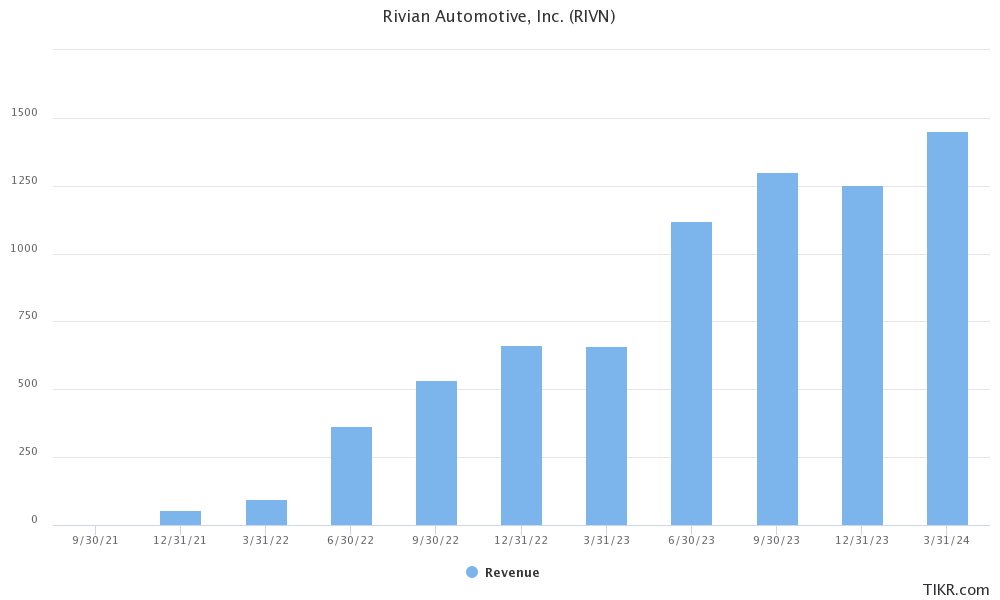Rivian Stock Slides After Company Plans a $1.5 Billion Capital Raise
Please note that we are not authorised to provide any investment advice. The content on this page is for information purposes only.
Rivian stock (NYSE: RIVN), which rose over 9% yesterday, is down by a similar quantum in US premarket price action today after the company announced a $1.5 billion convertible note offering, its second capital raise of the year.
In a private placement to qualified institutional buyers, the company is issuing green convertible bonds maturing in October 2030 and the holders would have the option to either redeem these in cash or convert them into common stock. The offering is similar to the $1.3 billion capital raise that the company completed in March.
Rivian announces capital raise to shore up its balance sheet
A Rivian spokesperson told Reuters “The purpose of this offering, similar to our raise earlier this year, is to de-risk the launch of R2 in Georgia.” They added, “Our primary goal is to maintain a conservative balance sheet.”
Notably, like fellow startup EV companies, Rivian is burning a lot of cash due to operating losses and capex. Lucid Motors has also completed two rounds of capital raise over the last year by issuing fresh shares.
Lucid Motors raised $1.5 billion cash by selling stocks in Q4 2022 and did another $3 billion capital raise in 2023. Of this, an affiliate of Saudi Arabia’s PIF (public investment trust) invested around $3.5 billion. PIF is the largest stockholder of Lucid Motors and holds over 60% stake in the company.
As for Rivian, Amazon is its biggest stockholder and holds over 16% stake in the company. Ford, which once held over 10% stake in the company has since pared the holdings to just above 1%.
EV companies are on a cash-raising spree
To be sure, EV companies have been on a capital-raising spree – including from strategic investors. Last month, Chinese EV company NIO completed a $1 billion convertible note offering which was preceded by a $738.5 million investment from CYVN Holdings L.L.C., an investment vehicle majority-owned by the Abu Dhabi Government in June.
Chinese EV company Xpeng Motors also partnered with Volkswagen which invested in the company and the two would jointly develop two models for the Chinese market.
Nikola has also raised capital multiple times and now has the shareholder authorization to issue even more shares. Nikola is restructuring its business to conserve cash and focus on key priorities. It has exited Europe to focus on North America and is also liquidating Romeo Power. It has also laid off employees and has been lowering its cost base.
Due to these measures, it managed to bring down its cash burn in Q2 2023 to just under $150 million and is looking to bring the annual cash burn to under $400 million by next year.
Having sufficient cash on the balance sheet de-risks the business from potential bankruptcy. Earlier this year, Lordstown Motors filed for bankruptcy after failing to raise funds while Arrival had to opt for a second SPAC merger.
Rivian is expanding its capacity
Rivian currently has one plant in Normal in the US. It is looking to set up a second plant in Georgia which would have an annual capacity of 400,000 cars. Rivian expects to have a total production capacity of 600,000 cars between the two plants.
It delayed the timeline for the affordable R2 vehicle platform by a year to 2026. The model would help Rivian scale up production.
The company however expects an adjusted EBITDA loss of $4.3 billion in 2023 and expects to post positive gross profits only by the next year.
Other EV startups are also struggling with losses and even the EV business of legacy automakers is in the red. Ford expects its EV business to lose $4.5 billion this year while General Motors does not expect its EV segment to turn profitable before 2025.
Rivian stock has fallen sharply from its peaks
When Rivian listed in 2021, it became the biggest listing since Facebook’s 2012 listing. Rivian’s IPO sailed through easily and the company priced the shares at $78 each, which was above the already increased price range. The stock had a good listing and went on to hit an all-time high of $179.47, which was over twice the IPO price.
At its peak, Rivian commanded a market cap of over $150 billion. Many saw it as a sign of optimism towards pure-play EV companies. However, there were skeptics, which included Tesla’s CEO Elon Musk, who found the valuation too high
The company’s market cap is now just above $22 billion. To put that in perspective, it had $9.1 billion as cash and cash equivalents on its balance sheet at the end of September, it said in its latest SEC filing.
The company would release its Q3 earnings in November but in the filing, it said that it expects revenues to be between $1.29 billion and $1.33 billion – which is slightly higher than what analysts were expecting.
Notably, Rivian produced 16,304 cars in Q3 and delivered 15,564 of these. It also maintained its 2023 production of 52,000 vehicles. Notably, while Tesla missed delivery forecasts in the third quarter, Rivian’s deliveries were better than expected.
Analysts on RIVN stock
After Rivian’s Q3 delivery report, Morgan Stanley reiterated its overweight rating on the stock. Evercore ISI analyst Chris McNally upgraded Rivian from inline to outperform and raised his target price to $35 while terming the company as a contender for being the “next Tesla.”
“RIVN has a brand that has stuck the US landing, and most importantly, within segments everyone already wants (SUV, Truck, Van),” said McNally in his note.
He listed three criteria namely, “brand,” “scale economics” and “vertical integration” and said, “We believe outside of Tesla & BYD, Rivian is the only OEM showing increased evidence of meeting all 3 criteria.”






